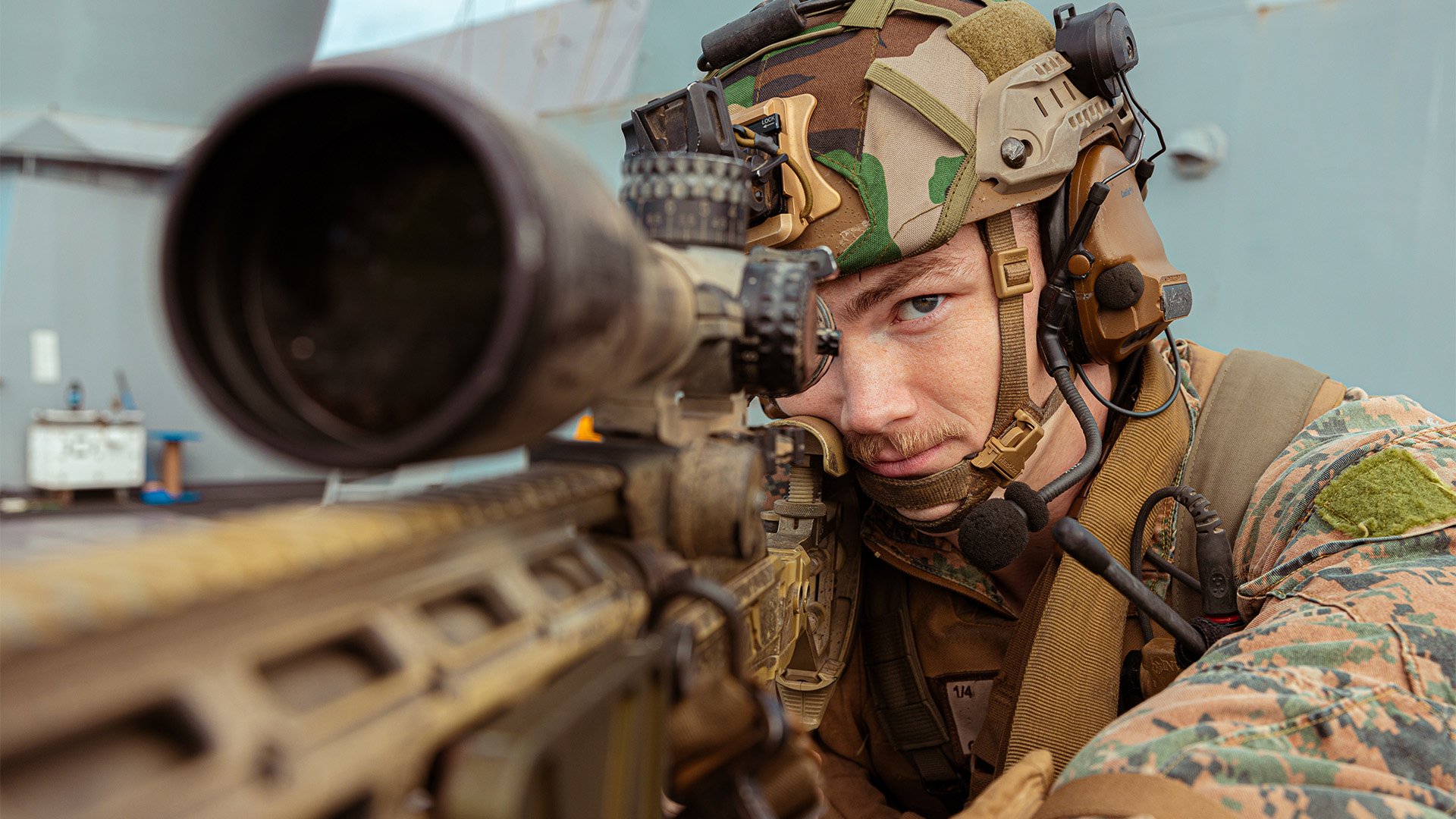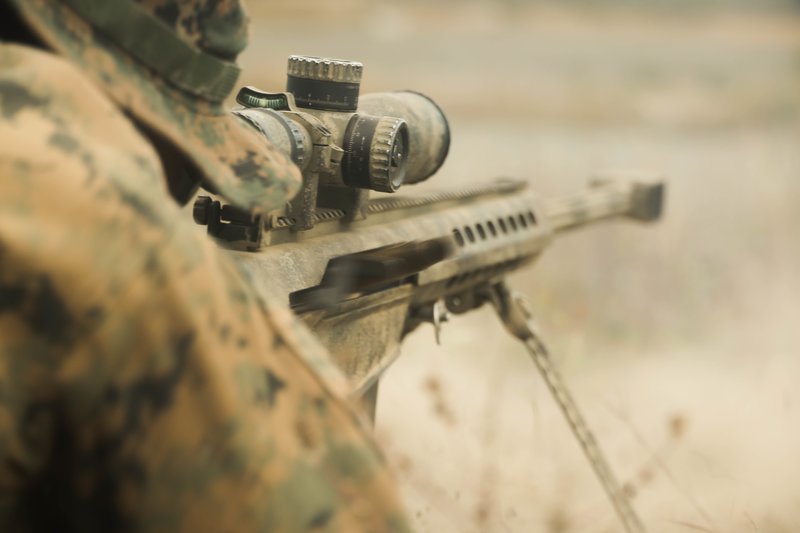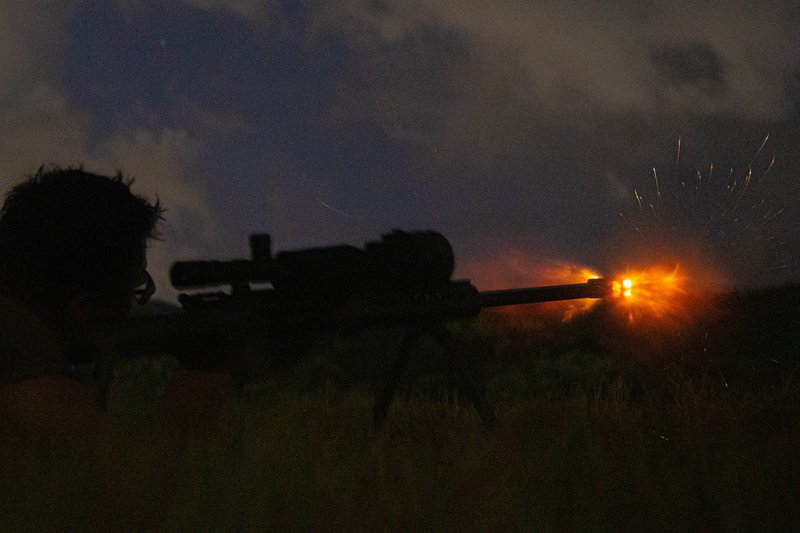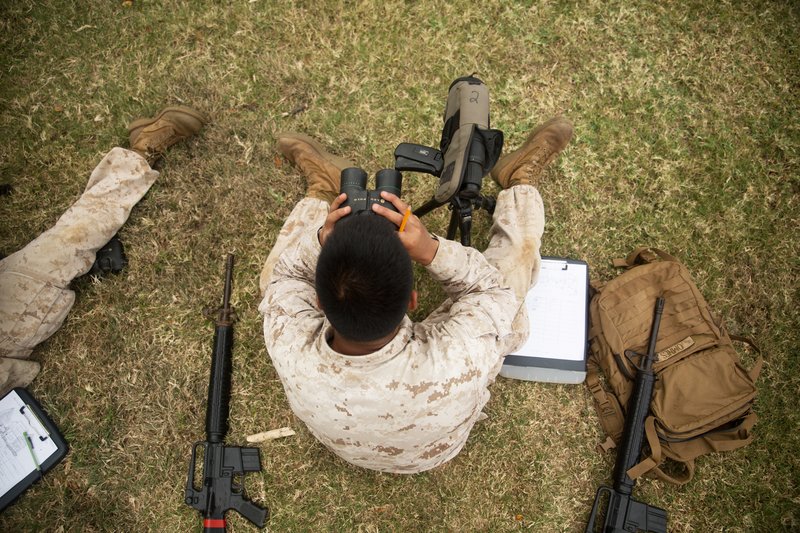
US Marine Corps Cpl. Adam Hytrek, a scout sniper with Battalion Landing Team 1/4, 31st Marine Expeditionary Unit, provides overwatch for a visit, board, search, and seizure exercise on the expeditionary mobile base Miguel Keith in the Philippine Sea, Feb. 11, 2023. A fleetwide message circulated a dozen days later radically revamped how he’ll do his job. US Marine Corps photo by Cpl. Vincent Pham.
With one shot from a fleetwide message, the Marine Corps brass killed off the service’s program for making and deploying legendarily lethal snipers.
A Feb. 23 blueprint detailing the “immediate” shift of 18-Marine sniper platoons into units with 26 scouts was provided to Coffee or Die, and it includes “zero allocated seats” for the sniper basic course in 2024.
That seemed to differ from an email from the US Marine Corps’ Training Command on Feb. 8 that assured Coffee or Die its leaders had “not received any formal requirement or task to modify the curriculum.”
“Should the decision be made to modernize that specific aspect of the training continuum, it will be based on a fleet requirement that is validated through Headquarters Marine Corps,” TECOM said in a prepared statement.
Neither Headquarters Marine Corps nor officials assigned to the program changing the sniper system responded to Coffee or Die’s inquiries about the fleetwide guidance that guts the sniper program.
According to the message, the change was made after Commandant Gen. David H. Berger’s Force Design 2030 “construct removed the Scout Sniper Platoon from the Infantry Battalion Table of Organization.”
“I’m worried about the loss of combat capabilities,” retired Master Sgt. Tim Parkhurst, the chief executive officer of the nonprofit USMC Scout Sniper Association, told Coffee or Die. “You can’t take a scout and get him to do the same thing a sniper can do. A scout is not a scout sniper.”

A scout sniper with 3rd Battalion, 3rd Marines, fires a M107 Special Application Scoped Rifle during Resolute Dragon 22 at Kamifurano Maneuver Area, Hokkaido, Japan, on Oct. 3, 2022. US Marine Corps photo by Sgt. Kallahan Morris.
Force Design 2030 is Berger’s ongoing crusade to make the Corps’ regiments into less infantry-centric units. Once finished, they promise to be more capable of downing enemy aircraft and killing their warships, with an eye on island hopping campaigns in the Pacific Ocean to confront a rising China, but the sniper platoons won’t be part of the mix.
According to the guidance, the message to the fleet was directed by Lt. Gen. David J. Furness, the deputy commandant for plans, policy, and operations at Headquarters Marine Corps.
His command is coordinating with Combat, Development & Integration to “remove the 0317 Billet Military Occupation Specialty (MOS) from infantry battalion T/O and establish the 0322 MOS (Reconnaissance Sniper) within the Reconnaissance Battalions.”
Experiments by the Corps revealed the scouting capabilities in the newly reconfigured infantry companies “were insufficient” to help battalion leaders gather “continuous all-weather information” on the battlefield, the message indicated.

Marines in 3rd Battalion, 3rd Marines, conduct a live-fire sniper range on Camp Schwab, Okinawa, Japan, Aug. 16, 2022. US Marine Corps photo by Cpl. Diana Jimenez.
Under Berger’s orders, the new scout platoons will consist of four teams of six infantry Marines. They’ll be led by a first lieutenant and a gunnery sergeant.
Battalions that don’t have enough infantry to form the larger scout platoons now will “immediately transition” their 18-Marine scout sniper platoons anyway to the new units, according to the directive.
Line battalions will rely on trained “designated marksmen and precision rifles,” the statement said.
This won’t apply to snipers attending formal schools at the Reconnaissance Training Center and Marine Raider Training Center. They will stay in their special operations units.

Lance Cpl. Alvin Omnes, a rifleman with 1st Battalion, 3rd Marine Regiment, uses a pair of binoculars to find hidden items in the bushes and grass on the side of a building during the scout sniper screening process at Dewey Square aboard Marine Corps Base Hawaii April 14, 2015. The Marines could use binoculars or a spotting scope and either lie down, sit, or stand during the screening process. US Marine Corps photo by Cpl. Khalil Ross.
Marine snipers trace their heritage back to a pair of World War II division-level schools — Green Farms in California and New River in North Carolina, plus the Scout Sniper Instructor School that opened in Quantico, Virginia, in 1977 — but they always formed a community with few commissioned officers to advocate for them at the Pentagon or Headquarters Marine Corps.
And it always was a secondary MOS, which meant the Marines never received the support of a detailed monitor from the same “one shot, one kill” community. Unlike reconnaissance Marines, snipers often returned to their line units as they advanced in enlisted rank.
It remains unclear if snipers within Marine Recon or Raider teams will be farmed out to line battalions if a war breaks out.
For Parkhurst, a key mission for his 1,350-member organization will be to comfort proud past and present snipers who are watching their old jobs disappear in a new Corps.
“This will be hard for a lot of Marines,” he said.
Read Next: Marine Sniper-Turned-MMA Fighter Takes on ‘Naked and Afraid’

Carl Prine is a former senior editor at Coffee or Die Magazine. He has worked at Navy Times, The San Diego Union-Tribune, and Pittsburgh Tribune-Review. He served in the Marine Corps and the Pennsylvania Army National Guard. His awards include the Joseph Galloway Award for Distinguished Reporting on the military, a first prize from Investigative Reporters & Editors, and the Combat Infantryman Badge.
BRCC and Bad Moon Print Press team up for an exclusive, limited-edition T-shirt design!
BRCC partners with Team Room Design for an exclusive T-shirt release!
Thirty Seconds Out has partnered with BRCC for an exclusive shirt design invoking the God of Winter.
Lucas O'Hara of Grizzly Forge has teamed up with BRCC for a badass, exclusive Shirt Club T-shirt design featuring his most popular knife and tiomahawk.
Coffee or Die sits down with one of the graphic designers behind Black Rifle Coffee's signature look and vibe.
Biden will award the Medal of Honor to a Vietnam War Army helicopter pilot who risked his life to save a reconnaissance team from almost certain death.
Ever wonder how much Jack Mandaville would f*ck sh*t up if he went back in time? The American Revolution didn't even see him coming.
A nearly 200-year-old West Point time capsule that at first appeared to yield little more than dust contains hidden treasure, the US Military Academy said.












